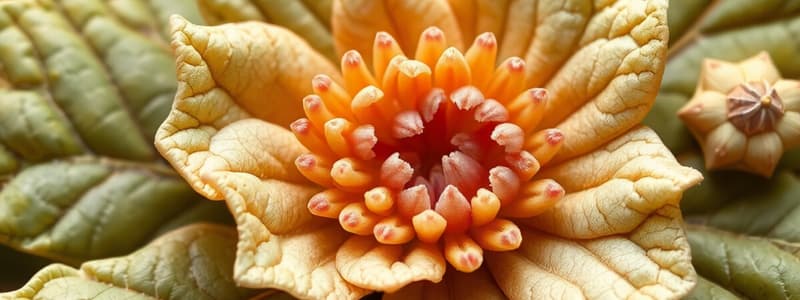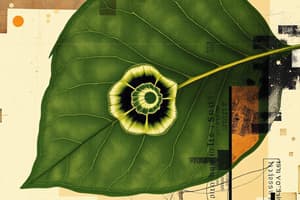Podcast
Questions and Answers
Explain the role of KOH pellets in Experiment No. 2 and why the water level in the bent tube rises.
Explain the role of KOH pellets in Experiment No. 2 and why the water level in the bent tube rises.
KOH pellets absorb carbon dioxide (CO2) released during the respiration of the germinating seeds. This reduction in CO2 concentration in the flask creates a partial vacuum, causing the water level in the bent tube to rise.
Describe the chemical equation for respiration and explain the significance of this process for living organisms.
Describe the chemical equation for respiration and explain the significance of this process for living organisms.
The chemical equation for respiration is: $C_6H_{12}O_6 + 6O_2 \longrightarrow 6CO_2 + 6H_2O + Energy$. This process is vital for living organisms because it breaks down glucose to release energy (ATP) needed for various life functions, like growth, movement, and repair.
What are the two main types of respiration and what differentiates them?
What are the two main types of respiration and what differentiates them?
The two main types of respiration are aerobic and anaerobic respiration. Aerobic respiration requires oxygen for complete oxidation of substrates, producing CO2 and water, while anaerobic respiration doesn't use oxygen, leading to incomplete oxidation and producing CO2 and ethanol (or other products).
Why is it necessary to soak the gram seeds overnight and germinate them before starting Experiment No. 2?
Why is it necessary to soak the gram seeds overnight and germinate them before starting Experiment No. 2?
What safety precautions should be taken during Experiment No. 2 and why?
What safety precautions should be taken during Experiment No. 2 and why?
Explain the process of binary fission and its relevance to single-celled organisms.
Explain the process of binary fission and its relevance to single-celled organisms.
In Experiment No. 3, how does the use of prepared slides contribute to the study of binary fission or budding?
In Experiment No. 3, how does the use of prepared slides contribute to the study of binary fission or budding?
How is the study of binary fission and budding important in understanding the diversity of life?
How is the study of binary fission and budding important in understanding the diversity of life?
What is the function of the cotyledons in a bean seed?
What is the function of the cotyledons in a bean seed?
Explain the difference between the epicotyl and the hypocotyl in a germinating seed.
Explain the difference between the epicotyl and the hypocotyl in a germinating seed.
Why is it important to ensure that the embryonal axis remains intact when separating the cotyledons?
Why is it important to ensure that the embryonal axis remains intact when separating the cotyledons?
What are the three main factors that need to be optimized for successful seed germination?
What are the three main factors that need to be optimized for successful seed germination?
Describe the role of the micropyle in seed germination.
Describe the role of the micropyle in seed germination.
What are stomata and what role do they play in a plant?
What are stomata and what role do they play in a plant?
Describe the difference in stomatal behavior when exposed to light versus darkness.
Describe the difference in stomatal behavior when exposed to light versus darkness.
What types of stomatal distribution can be observed in dicot and monocot leaves?
What types of stomatal distribution can be observed in dicot and monocot leaves?
Why is it important to select a turgid leaf for observation during the experiment?
Why is it important to select a turgid leaf for observation during the experiment?
Explain the procedure for preparing a temporary mount of a leaf peel.
Explain the procedure for preparing a temporary mount of a leaf peel.
What precautions should be taken when mounting a leaf peel for observation?
What precautions should be taken when mounting a leaf peel for observation?
What observations can be made about the structure of stomata in a dicot leaf after exposure to sunlight?
What observations can be made about the structure of stomata in a dicot leaf after exposure to sunlight?
What is the significance of guard cells in the functioning of stomata?
What is the significance of guard cells in the functioning of stomata?
What are daughter cells in the context of binary fission in Amoeba?
What are daughter cells in the context of binary fission in Amoeba?
Describe the first observation that occurs during the binary fission of Amoeba.
Describe the first observation that occurs during the binary fission of Amoeba.
How does budding in yeast differ from binary fission in Amoeba?
How does budding in yeast differ from binary fission in Amoeba?
What role do cotyledons play in dicot seeds?
What role do cotyledons play in dicot seeds?
What are the key parts of an embryo in dicot seeds?
What are the key parts of an embryo in dicot seeds?
What should a student do before observing slides under high power with a microscope?
What should a student do before observing slides under high power with a microscope?
What is the significance of seed germination in plants?
What is the significance of seed germination in plants?
What observation can be made during budding in Hydra?
What observation can be made during budding in Hydra?
Flashcards
What is respiration?
What is respiration?
Respiration is the process where living cells break down organic compounds like glucose to release energy, usually in the form of ATP.
What is Aerobic Respiration?
What is Aerobic Respiration?
Aerobic respiration uses oxygen to completely break down glucose, producing carbon dioxide and water as byproducts.
What is Anaerobic Respiration?
What is Anaerobic Respiration?
Anaerobic respiration does not use oxygen and breaks down glucose partially, producing carbon dioxide and other byproducts like alcohol.
What is binary fission?
What is binary fission?
Signup and view all the flashcards
What is budding?
What is budding?
Signup and view all the flashcards
Stomata
Stomata
Signup and view all the flashcards
Guard cells
Guard cells
Signup and view all the flashcards
Stomatal distribution
Stomatal distribution
Signup and view all the flashcards
Hypostomatous
Hypostomatous
Signup and view all the flashcards
Amphistomatous
Amphistomatous
Signup and view all the flashcards
Epistomatous
Epistomatous
Signup and view all the flashcards
Stomata opening during the day
Stomata opening during the day
Signup and view all the flashcards
Stomata closing during the night
Stomata closing during the night
Signup and view all the flashcards
Binary fission
Binary fission
Signup and view all the flashcards
Budding
Budding
Signup and view all the flashcards
Radicle
Radicle
Signup and view all the flashcards
Epicotyl
Epicotyl
Signup and view all the flashcards
Cotyledons
Cotyledons
Signup and view all the flashcards
Seed germination
Seed germination
Signup and view all the flashcards
Seed coat
Seed coat
Signup and view all the flashcards
Node
Node
Signup and view all the flashcards
Cotyledons (Bean Seed)
Cotyledons (Bean Seed)
Signup and view all the flashcards
Plumule
Plumule
Signup and view all the flashcards
Hypocotyl
Hypocotyl
Signup and view all the flashcards
Study Notes
Biology Experiments
-
Experiment 1: Preparing a temporary mount of a leaf peel to show stomata.
- The experiment involves preparing a temporary mount of a leaf peel to observe stomata.
- Materials needed include a leaf (mesophytic dicot), microscope, glass slides, distilled water, droppers, glycerol, coverslips, forceps, etc.
- Stomata are structures in leaves responsible for gas exchange. Two guard cells surround the stomata, with subsidiary cells in the epidermis.
- Stomata typically open in the light and close in the dark.
- Guard cell turgidity controls stomata opening and closing.
- Stomatal distribution types include hypostomatous (lower surface), amphistomatous (both surfaces, more on lower), and epistomatous (upper surface).
- Procedure for preparing the mount involves taking a leaf, placing it on a glass slide, adding glycerine, covering with a coverslip, observing under a microscope.
-
Experiment 2: To show that carbon dioxide is produced during respiration.
- This experiment demonstrates carbon dioxide production during respiration.
- Materials include a conical flask, beaker, test tube, KOH pellets, a glass tube bent at right angles, cork, thread, presoaked gram seeds, colored water.
- Respiration is a vital process where organic compounds break down and release energy, and often CO2.
- Respiration is both aerobic (using oxygen) and anaerobic (without oxygen).
- Aerobic respiration produces CO2, water, and energy (ATP).
- Anaerobic respiration produces carbon dioxide and ethyl alcohol.
- Procedure includes soaking gram seeds, placing them in a conical flask, suspending a test tube of KOH pellets, fitting a bent glass tube into the cork, and observing changes in water level as respiration occurs, releasing CO2 which is absorbed by the KOH.
-
Experiment 3: To study binary fission in Amoeba or Paramecium, and budding in Yeast and Hydra.
- This experiment involves observing asexual reproduction in Amoeba, yeast, and Hydra.
- Materials include a compound microscope, prepared slides of binary fission, and prepared slides of budding.
- Binary fission is a method of asexual reproduction where an organism divides into two. Parent cell elongates and divides its nucleus into two.
- Daughter cells are produced, and they separate and redivide after maturity.
- Budding is another asexual reproduction mechanism. A small outgrowth (bud) develops on the parent organism, containing some of its components. The bud eventually grows into an individual organism.
- Microscopy is the procedure for observation
-
Experiment 4: To identify different parts of an embryo of a dicot seed (Pea, Gram, or Red kidney bean).
- This experiment focuses on identifying parts of a dicot embryo,
- Materials include a petri dish, absorbent cotton wool, germinating seeds, forceps, and needles.
- Embryo parts like cotyledons (food storage), plumule (shoot tip), hypocotyl (stem region below cotyledons), radicle (embryonic root), and micropyle (opening in the seed coat) are identified and observed.
- Germination involves the process of seed growth.
Studying That Suits You
Use AI to generate personalized quizzes and flashcards to suit your learning preferences.
Related Documents
Description
Explore the fascinating world of stomata through a series of biology experiments. This quiz covers the preparation of a temporary mount of a leaf peel to observe stomata, their structure, function, and the factors influencing their opening and closing. Understand how stomata contribute to gas exchange in plants.




